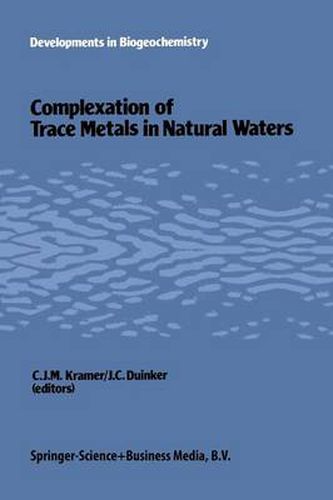Readings Newsletter
Become a Readings Member to make your shopping experience even easier.
Sign in or sign up for free!
You’re not far away from qualifying for FREE standard shipping within Australia
You’ve qualified for FREE standard shipping within Australia
The cart is loading…






This title is printed to order. This book may have been self-published. If so, we cannot guarantee the quality of the content. In the main most books will have gone through the editing process however some may not. We therefore suggest that you be aware of this before ordering this book. If in doubt check either the author or publisher’s details as we are unable to accept any returns unless they are faulty. Please contact us if you have any questions.
It is presently well recognized that total concentrations of trace elements in any environmental compartment supply insufficient information to understand important phenomena. The distinction and separate analysis of specific chemical species are essential for understanding cycles in the aquatic environment, involving identification and quantification of sources, transport pathways, distributions and sinks, or, in the area of interactions between trace elements and organisms to understand uptake, distribution, excretion mechanisms and effects. In the past, various ways have been developed to determine the nature and extent of complexation of trace elements in natural systems. Approaches have been followed along very different lines. These have not always been fully appreciated by specialists working in even related fields of complexation research. The first International Symposium on the Complexation of Trace metals in Natural Waters was held at the Netherlands Institute for Sea Research (NIOZ, Texel, the Netherlands from 2-6 May 1983. The scientific programme was planned by the chief organizers Drs. C.J.M. Kramer and J.C. Duinker (NIOZ) together with Prof. Dr. H.W. Nurnberg (Kernforschungsanlage, Julich, Federal Republic of Germany) and Dr. M. Branica (Rudjer Boskovic Institute, Zagreb, Yugoslavia).
$9.00 standard shipping within Australia
FREE standard shipping within Australia for orders over $100.00
Express & International shipping calculated at checkout
This title is printed to order. This book may have been self-published. If so, we cannot guarantee the quality of the content. In the main most books will have gone through the editing process however some may not. We therefore suggest that you be aware of this before ordering this book. If in doubt check either the author or publisher’s details as we are unable to accept any returns unless they are faulty. Please contact us if you have any questions.
It is presently well recognized that total concentrations of trace elements in any environmental compartment supply insufficient information to understand important phenomena. The distinction and separate analysis of specific chemical species are essential for understanding cycles in the aquatic environment, involving identification and quantification of sources, transport pathways, distributions and sinks, or, in the area of interactions between trace elements and organisms to understand uptake, distribution, excretion mechanisms and effects. In the past, various ways have been developed to determine the nature and extent of complexation of trace elements in natural systems. Approaches have been followed along very different lines. These have not always been fully appreciated by specialists working in even related fields of complexation research. The first International Symposium on the Complexation of Trace metals in Natural Waters was held at the Netherlands Institute for Sea Research (NIOZ, Texel, the Netherlands from 2-6 May 1983. The scientific programme was planned by the chief organizers Drs. C.J.M. Kramer and J.C. Duinker (NIOZ) together with Prof. Dr. H.W. Nurnberg (Kernforschungsanlage, Julich, Federal Republic of Germany) and Dr. M. Branica (Rudjer Boskovic Institute, Zagreb, Yugoslavia).